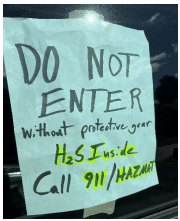This article will discuss suicide, specifically chemical suicide, and intends to do so from a perspective of public safety and information regarding involved first responders. If you or someone you know is battling with suicidal thoughts or actions or is in crisis, know there is help. 988 is the suicide and crisis lifeline; you’re not alone, help is available.
Chemical Suicide.
First responders and law enforcement officials face many challenges and responsibilities. Daily encounters may range from providing community support to serious cases of life-threatening safety. There is no single day that mirrors another yet the aid these responders provide never falters. Among those many responsibilities that our heroes face, one is ever daunting and unexpected: chemical suicide.
“Chemical suicides involve the use of lethal toxic gases generated by intentionally mixing common household
chemicals in a confined space such as a car, bathroom, or closet. Indicators of a chemical suicide in these
confined spaces may include signs posted warning of toxic gas, empty cleaning supply containers, and a
victim showing no signs of trauma.” (NIOSH, 2023)
The Environment.
Chemical suicide presents a set of challenges for response, not unlike a chemical disaster or HazMat event. The need for extreme safety measures arises from several factors that are unique to these situations which will be discussed below. Rescuers responding to the scene of a chemical suicide are at risk of exposure to highly toxic chemicals and may not always know it.
To understand responses to potential chemical suicides, it is important to note that the threat of exposure to toxic chemicals depends on the concentration of that chemical in a space. Concentration in cases of chemical suicide is determined on (1) the amount of a chemical and (2) the size of a space.
Concentration:
IDLH is a common term used in hazmat scenarios. IDLH means Immediately Dangerous to Life or Health. The acronym represents “An atmospheric concentration of any toxic, corrosive or asphyxiate substance that poses an immediate threat to life or would cause irreversible or delayed adverse health effects or would interfere with an individual’s ability to escape from a dangerous atmosphere. IDLH values are based on effects that might occur as a consequence of a 30-minute exposure.
Confined Spaces:
As an example, imagine you are using bleach to clean in a small, enclosed bathroom and immediately smell strong chemical fumes. Now imagine cleaning with the same amount of bleach in an open kitchen. In the second scenario, the smell of bleach is noticeable however it is not as strong as before. This example illustrates how the size of a space impacts concentration. Confined spaces offer less opportunity for dilution of a toxic chemical.
Most chemical suicides occur in confined spaces.
Impacting First Responders:
Considering the above points, chemical suicides take place in confined spaces with very high concentrations of toxic chemicals, at or near IDLH. Because of these factors, it is important that first responders take necessary precautions during responses to potential chemical suicide. Some responses include signs or warnings from the victim as shown in the photo below. Many times, first responders and LEOs do not have warnings of dangers they may find.

Recommendations
NIOSH has developed a safety and health advisory that provides recommendations for protecting individuals who respond to these emergencies. One key recommendation is to treat all chemical suicides as HAZMAT events. However, not all responders to these events are provided with warning signs from the victims, and not all events can be immediately identified as chemical suicides. Not all responses to chemical suicides are predictable.
With first responders’ lives in mind, Morphix Technologies designed the Chameleon Chemical Detection Armband Chemical Suicide Detection Kit. This gives wearers the tools they need to assess a situation’s safety almost instantaneously. Chameleon Cassettes detect target chemicals at ½ IDLH in about 3 minutes. This quick response allows responders to remove themselves from danger and reassess necessary safety measures.
The Chameleon Chemical Detection Armband Chemical Suicide Detection Kit includes cassettes for Low pH (Acid), High pH (Base), Hydrogen Sulfide, Sulfur Dioxide, and Phosphine—commonly encountered toxic chemicals in chemical suicide cases.

